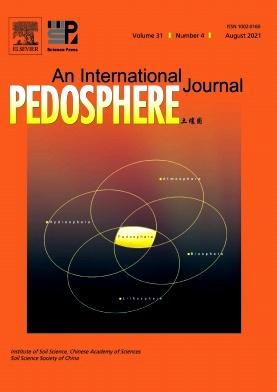植物修复剂中微生物辅助的金属耐受机制综述
IF 7.3
2区 农林科学
Q1 SOIL SCIENCE
引用次数: 0
摘要
随着人类活动的加剧,环境基质中的重金属污染日益严重。由于它们的顽固性和毒性,它们在环境中的高滴度会威胁到生物成分的生存。为了减轻压力,植物修复剂对金属污染场地的修复被认为是一种生态可持续的方法,因为植物修复剂具有承受重金属压力和熄灭有害金属的潜力。尽管潜力巨大,但由于金属浓度高、多种污染物的发生、植物生物量低以及土壤理化状况在细胞和分子水平上影响植物,导致形态、生理和遗传改变,植物修复技术受到挫折。然而,用微生物增加土壤可以缓解这一挑战。微生物,特别是促进植物生长的微生物(PGPMs)和植物修复剂之间的积极联系可以通过产生次生代谢物、溶解磷酸盐、合成1-氨基环丙烷-1-羧酸(ACC)脱氨酶和植物激素等策略来预防植物毒性并增强植物修复。微生物可以通过强化其抗氧化机制来调节植物的耐受性,维持氧化还原稳态,减轻金属诱导的植物氧化损伤。相关的微生物也可以激活植物的应激反应基因,减轻金属诱导的毒性作用。深入探索植物相关微生物触发植物修复剂耐受性的机制对于提高植物修复潜力和实际应用至关重要。本文试图全面回顾这些机制,最终促进土壤生态系统修复改进/新技术的发展。本文章由计算机程序翻译,如有差异,请以英文原文为准。
Mechanisms of microbe-assisted metal tolerance in phytoremediators: A review
Escalating anthropogenic activities have caused heavy metal contamination in the environmental matrices. Due to their recalcitrant and toxic nature, their occurrence in high titers in the environment can threaten survival of biotic components. To take the edge off, remediation of metal-contaminated sites by phytoremediators that exhibit a potential to withstand heavy metal stress and quench harmful metals is considered an eco-sustainable approach. Despite the enormous potential, phytoremediation technique suffers a setback owing to high metal concentrations, occurrence of multiple pollutants, low plant biomass, and soil physicochemical status that affect plants at cellular and molecular levels, inducing morphological, physiological, and genetic alterations. Nevertheless, augmentation of soil with microorganisms can alleviate the challenge. A positive nexus between microbes, particularly plant growth-promoting microorganisms (PGPMs), and phytoremediators can prevent phytotoxicity and augment phytoremediation by employing strategies such as production of secondary metabolites, solubilization of phosphate, and synthesis of 1-aminocyclopropane-1-carboxylic acid (ACC) deaminase and phytohormones. Microbes can mediate tolerance in plants by fortifying their antioxidant machinery, which maintains redox homeostasis and alleviates metal-induced oxidative damage in the plants. Associated microbes can also activate stress-responsive genes in plants and abridge metal-induced toxic effects. An in-depth exploration of the mechanisms employed by plant-associated microbes to trigger tolerance in phytoremediators is crucial for improving their phytoremediation potential and real-world applications. The present article attempts to comprehensively review these mechanisms that eventually facilitate the development of improved/new technology for soil ecosystem restoration.
求助全文
通过发布文献求助,成功后即可免费获取论文全文。
去求助
来源期刊

Pedosphere
环境科学-土壤科学
CiteScore
11.70
自引率
1.80%
发文量
147
审稿时长
5.0 months
期刊介绍:
PEDOSPHERE—a peer-reviewed international journal published bimonthly in English—welcomes submissions from scientists around the world under a broad scope of topics relevant to timely, high quality original research findings, especially up-to-date achievements and advances in the entire field of soil science studies dealing with environmental science, ecology, agriculture, bioscience, geoscience, forestry, etc. It publishes mainly original research articles as well as some reviews, mini reviews, short communications and special issues.
 求助内容:
求助内容: 应助结果提醒方式:
应助结果提醒方式:


